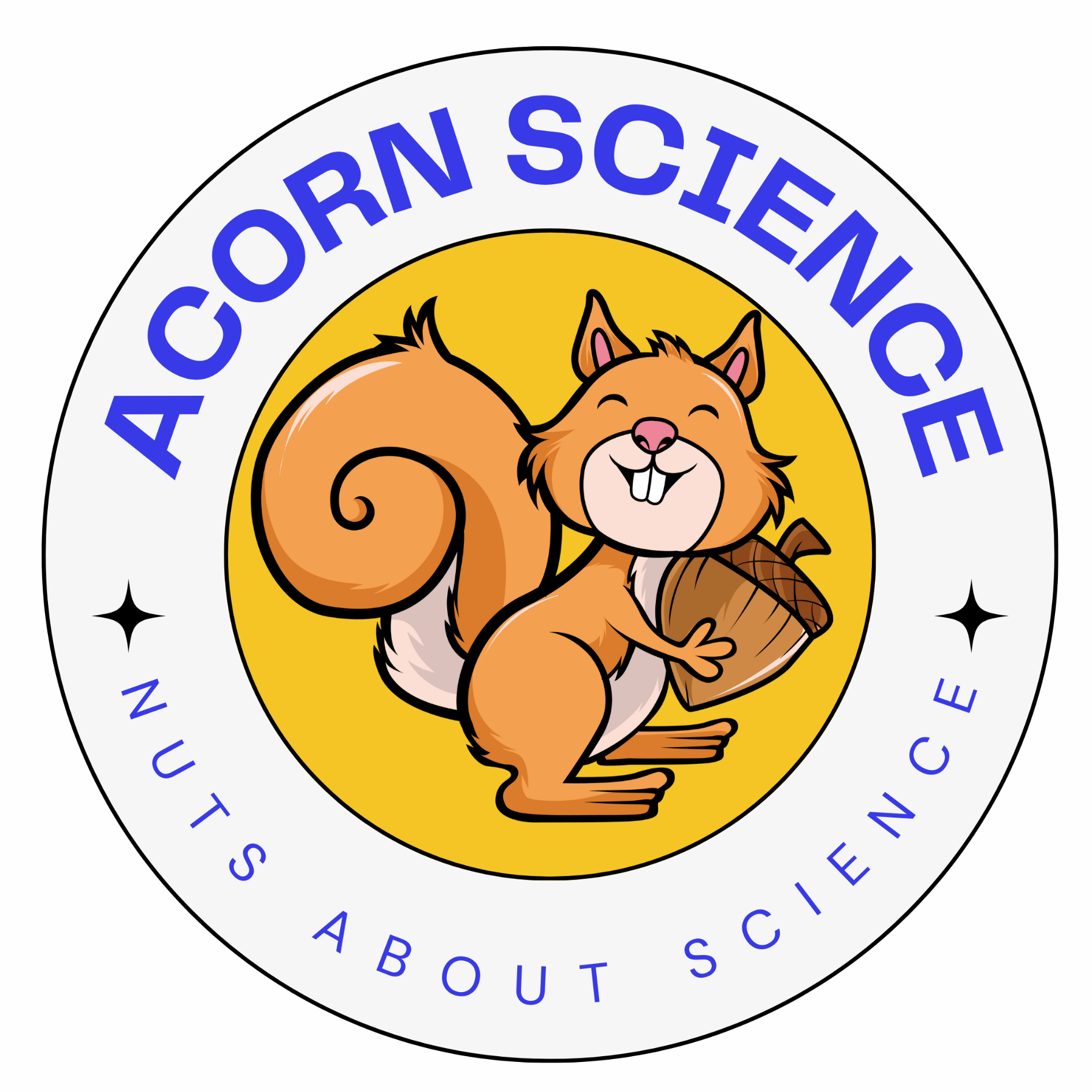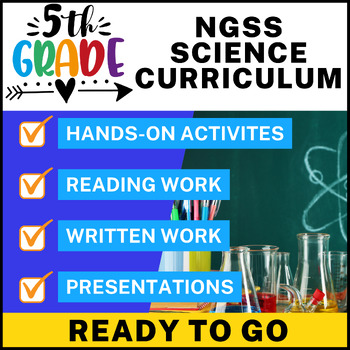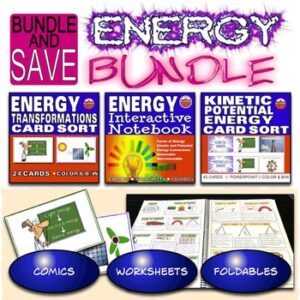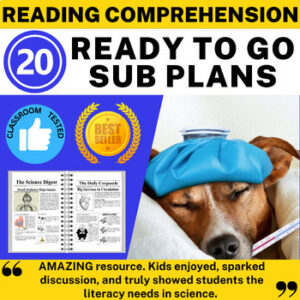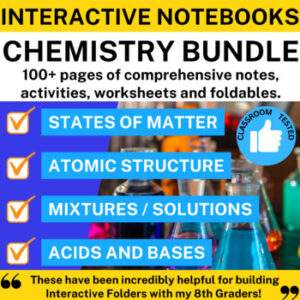Description
This pack has everything you need to teach 5th grade Science using the NGSS curriculum. Save yourself countless hours prepping and get all the resources you need to teach the entire 5th Grade NGSS Science curriculum in this massive bundle. Engaging lessons that both students and teachers love. 5th Grade Earth Science, 5th Grade Life Science and 5th Grade Physical Science are all covered and aligned to the NGSS standards. Check out the previews for each product.
5th Grade Physical Science
States of Matter Interactive Notebook (NGSS 5-PS1-1) – Your students are going to love these States of Matter Interactive Notebook Pages! No-prep just print and go! These INB pages are easy to follow and fun to use and teach with.
The following topics are covered:
- Matter, Mass, Weight, Volume
- Matter is made up of smaller particles
- Solids, Liquids, Gases
- States of Matter Definitions/Vocabulary Foldable
- Particle Arrangement in Solids, Liquids, Gases
- Melting
- Evaporation
- Condensation
- Freezing
States of Matter Powerpoint and Quiz (NGSS 5-PS1-1). This is a really engaging powerpoint presentation that covers the NGSS 5-PS1-1 standard “develop a model to describe that matter is made of particles too small to be seen“. A quiz is also included (you can make this a team event or individual).
- States of Matter Science Stations – Skittles and the states of matter! Your students are going to love these science stations! These states of matter stations are easy to follow and fun to use and teach with.
- Make It – at this station the students will make simple models showing how particles are arranged in solids, liquids and gases. This is a really fun station and they’ll remember the arrangement and understand the properties of the different states because they model them here.
- Match It – students will match the pictures to the questions and the answer letters will make up a surprise word!
- Label It – students are shown the stages in the changing of states together with labels. They must label their diagram using the supplied labels.
- Draw It – At this station the students will draw the particle structure for each state of matter.
- Explain It – Here the students will look at photos of common changes of state that they will be familiar with around the home and explain what is happening.
- Describe It – at this station the students will describe the various changes of states in a candle.
Changing States of Matter Bingo – your students will love this Changing State of Matter Bingo game! Easy to follow and great fun to use and teach with. You don’t have to add anything. It’s Bingo like it’s never been played before!
This is a great activity for consolidating learning, as a class reward or as a review.
- 30 unique bingo cards
- Ink Saver version included
- 24 Questions
- Graphic Hints on each card
- Answers are included on the teacher sheet
Conservation of Matter Lab NGSS 5-PS1-2 – this lesson has been designed to align with the NGSS standard 5-PS1-2 “measure and graph quantities to provide evidence that regardless of the type of change that occurs when heating, cooling, or mixing substances, the total weight of matter is conserved”.
- Conservation of Matter using Skittles – in this activity the students will measure and graph the weights of sorted and unsorted skittles.
- Conservation of Matter using a Salt Water Solution – this activity build upon the Skittles activity. The students will dissolve salt into water and compare the weights before and after the reaction and graph their results
Also included is a powerpoint on the conservation of matter.
Properties of Matter 5-PS1-3 – this lesson has been designed to align with the NGSS standard 5-PS1-3 “make observations and measurements to identify materials based on their properties”.
There are 3 easy to use hands-on activities in this packet.
- Hardness of Materials – in this short lab the students will compare the hardness of common household objects and rank them on a scale (provided).
- Electrical Conductivity – both you and your students are going to love this one! They’re going to make a simple electrical circuit (using aluminum foil) and test common items to see if they conduct electricity or not. Full instructions with photos are included. This experiment is designed to work with the minimum of fuss. Expect lots of “wow this is cool”!.
- Mystery Powders Lab – this is a fun lab where they’ll test common household powders and then see if they can identify a mystery powder. Photos of what you can expect to see are included.
Chemical Reactions NGSS 5-PS1-4 – This lesson has been designed to align with the NGSS standard 5-PS4-1 “ conduct an investigation to determine whether the mixing of two or more substances results in new substances”.
Included in this pack are:
- What I Know About Physical and Chemical Changes – this activity is to see what their existing knowledge of physical and chemical changes is and what they want to know. I’ve included a panel of hints and given an example of each to help them get started.
- Physical and Chemical Changes Reading Comprehension – students read about the differences between common everyday physical and chemical changes and the clues that scientists look for to see if a chemical reaction has taken place. They will answer questions based on the passage.
- Chemical Reactions – Make A Lava Lamp – this is a fun activity the students will remember. In this experiment they’re going to make their own lava lamps powered by a simple everyday chemical reaction – effervescent tablets. It’s a great way to show them that some chemical reactions produce a fizz.
- Chemical Reactions – Change of Color This a really simple hands on experiment they’re going to love! They will make their own red cabbage indicator (no boiling required) and test simple household substances to see if they’re acidic, basic or neutral. They’re also going to see what happens when you mix an acid and a base together and the importance of a control.
5th Grade Earth Science
5th Grade The Brightness of Stars (NGSS 5-ESS1-1)
This lesson has been designed to align with the NGSS standard 5-ESS1-1 “support an argument that the apparent brightness of the sun and stars is due to their relative distances from the Earth”.
- Powerpoint – this powerpoint gives an overview of the lifecycle of a star and then looks at our nearest star the sun. The presentation can be done before or after the activities.
- What I know About Stars – this activity is to see what their existing knowledge of stars is and what they want to know.
- Our Sun and Other Stars Reading Comprehension – this activity looks at our sun as well as other stars. It introduces the concepts of star size, star brightness and the vast distances in space. The reading passage is followed by questions to elicit their understanding.
- Watch It Activity – this is a lovely activity that can be shown to the whole group or they can do it independently. This is a short video that compares the sizes of stars in a wonderfully visual way. Students answer questions based on the video on the worksheet.
- Star Size Comparison – in this activity the students are provided with facts about stars and a worksheet with the star sizes in the correct proportion. They can make an infographic or a poster based on the facts. Perfect to decorate your classroom!
- Explain It – This is a short exercise where students are given information that they must explain. It focuses on them explaining why objects of different sizes are less bright than our sun. The last question is designed to stretch them asking them to explain why two similar stars have different brightness.
- Make It Activity – in this activity the students are shown the Orion constellation and must join the dots to make the shape of the hunter. I’ve also included a simplified version.
Wordsearch / Crossword
I’ve included both a Wordsearch and a Crossword. The Crossword is a little more challenging, perfect as an alternative to a quiz.
5th Grade Shadow Length and Direction (NGSS 5-ESS1-2)
- What I Know About Shadows – this activity is to see what their existing knowledge of shadows is and what they want to know.
- Compare It Activity – this activity looks at two graphs showing the length of shadows during one day in the same city in February and in June. The students are asked to examine and compare both graphs and answer questions. Then they’ll infer which graph is February and which is June and explain why.
- Making Shadows – in this activity the students will recreate shadows using a torch and a match. This activity is designed to get them thinking about how the position of the torch (sun) changes the length of shadows.
- Graph It Activity – the students are given a table showing the length of a shadow at 2 hour intervals during the day. They will make a graph based on this information. I’ve included multiple versions of the graph to cater for all levels of ability.
- Shadow Tracking Activity – in this activity the students track the shadow of a stick or ruler during the day. This is done outside. They make an outline of the shadow using chalk and write the time beside it. They can take a picture of their experiment at the end of the day.
- Draw It – this is a lovely activity where students draw a line from the sun to the top of the scientists head to the ground. In this activity they’ll see how the position of the sun affects the length and position of a shadow.
- Tech It – the students will use an online simulator to view the star constellations on different days/months. They will be able to identify constellations that are always visible and ones that are not always visible.
Earth’s Spheres (NGSS 5-ESS2-1)
This lesson has been designed to align with the NGSS standard 5-ESS2-1 “ develop a model using an example to describe ways the geosphere, biosphere, hydrosphere, and/or atmosphere interact”.
- Bottle Biomes Reading Comprehension – students read about the oldest bottle garden in the world. This garden hasn’t been watered in 40 years! They will compare this sealed biome to the Earth and answer questions based on the passage.
- Make Your Own Bottle Biome – this is a fun activity the students will remember. In this experiment they’re going to make their own bottle biome. They’ll see photosynthesis, water evaporation and condensation (rain). Once their biome is up and running they only need to observe it. Their biome may last for years.
- Biosphere – students read about the Earth’s biosphere and biomes and answer questions based on the text. A fun coloring activity accompanies this where they color biomes and describe the animal and plant life found there.
- Geosphere – students read about the Earth’s geosphere and the world’s deepest hole. A fun coloring activity accompanies this where they label and color two diagrams to help them understand the layers of the earth.
- Hydrosphere – this activity asks students to answer T/F to a series of questions on the Earth’s hydrosphere.
- Atmosphere – the students are given facts about the atmosphere and the different layers. They can color in their diagram and add images to make the layers more memorable.
- Figure It Out – the Water Cycle. In this activity the students must try to figure out the journey of a drop of water from observing a diagram of the water cycle.
- Oceans, Wind, Mountains – the effect of mountain ranges on climate is investigated in this activity. Students will then draw their own labelled diagram to illustrate their understanding. I’ve also included a photo showing this effect and the students will study it and answer questions.
Distribution of Water on Earth (NGSS 5-ESS2-2)
This lesson has been designed to align with the NGSS standard 5-ESS2-2 “describe and graph the amounts of salt water and fresh water in various reservoirs to provide evidence about the distribution of water on Earth”.
- Distribution of Earth’s Water Reading Comprehension – students read about the distribution of water on earth and discover how little freshwater there is available to drink. They will answer questions based on the passage.
- Draw It – this is a fun activity that shows the students the total volumes of water and freshwater compared to the size of the earth. After reading the explanation they can create, label and color their own version.
- Make It – this is a great visualization of the amounts of water on Earth. The students will add water to cups to compare the total amount of water on earth, the amount of freshwater and the amount of river/lake water. This really helps them visualize and understand the tiny amounts of water available.
- Graph It – Total Water in this activity the students title, label and color a pie chart comparing the percentage of ocean water with freshwater on Earth. I’ve pre-made this pie chart as the difference in percentages is so wide that it can be difficult to make a readable graph.
- Graph It – Freshwater in this activity the students will draw a bar graph comparing the amounts of freshwater on earth.
- Graph It – Surface Freshwater in this activity the students will draw a bar graph comparing the amounts of surface freshwater on earth.
- Wordsearch and Crossword
5th Grade Human Impact on the Environment (NGSS 5-ESS3-1)
- Read It Air Pollution – students read about the problems of air pollution in Dublin in the 1980s and how the Irish government corrected the problem. They will answer questions based on the passage.
- Tech It Deforestation in the Amazon – this is a two part activity. In the first part the students will visit a website and look at the deforestation of Brazil. In the second part they’ll look at the causes and effects of deforestation.
- Illustrate It – students are provided with information on the ways deforestation is being reversed. They will use this information to create a poster or infographic.
- Describe It – students examine photos of the Aral Sea and read about the human activity that caused it to dry up as well the attempts to replenish the sea.
- Explain It Plastics – students read about the blessing and curse that is plastic along with possible solutions to the problem of disposal. Students answer questions on the text.
- Crossword and Wordsearch – I’ve included both a crossword and a wordsearch that will help as a vocabulary builder and is a lovely way to review the lesson. Perfect for early finishers!
5th Grade Life Science
5th Grade What Do Plants Need to Grow? (NGSS 5-LS1-1)
- Plants without Soil Reading Comprehension – students read about plants that grow without soil (air plants and hydroponics) and answer questions based on the passage.
- Activity – Do Plants Use Up Soil? Many students think that plants eat soil. In this experiment they’re going to germinate seedlings in both soil and cotton wool and observe the change in height over the course of 10 days. They’re also going to observe the levels of the soil and see that the plant doesn’t use up the soil and that the nutrients/matter must come from elsewhere.
- Activity – Do Plants Need Water to Grow? This is a lovely activity where the students can experiment with seeds to see if they’ll germinate without water.
- Draw It Activity – Photosynthesis Overview In this activity the students will draw and label their own overview of photosynthesis. I’ve included two versions of this activity one with the words and one without.
- Activity – Do Leaves Breathe? In this activity the students will experiment with leaves to see the bubbles of oxygen they release.
5th Grade Matter and Energy in an Ecosystem (NGSS 5-LS2-1)
- Read It – the students read about the reintroduction of wolves to Yellowstone and the dramatic effect it had on the entire ecosystem.
- Identify It – at this station the students learn about producers, consumers and decomposers and identify them.
- Watch It -student watch a short (3m) video on the importance of decomposers and answer questions based on the video.
- Describe It – at this station students describe and identify the various parts of a food chain and how everything is interconnected.
- Make It – here students will make their own food chains /webs and answer questions on it.
Read It – at this station the students will read about the effects of an invasive species and answer questions on it.
